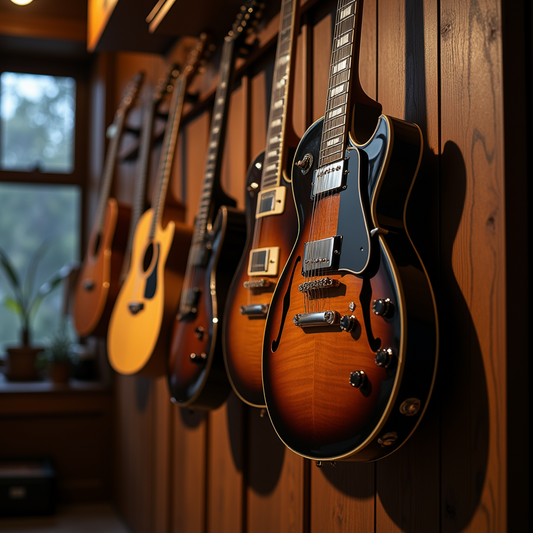How to Choose an Electric Guitar as a Beginner: The Ultimate Guide
Share
Introduction
Picking your first electric guitar is an exciting milestone, but with so many options available, it can be overwhelming. As a beginner, you want to make sure you're selecting the right guitar that suits your style, sound preferences, and budget. In this guide, we’ll walk you through the essential factors to consider when choosing an electric guitar for beginners, so you can start playing with confidence and passion.
1. Set Your Budget
Why Budget Matters As a beginner, it’s crucial to set a realistic budget for your first electric guitar. Electric guitars come in a wide range of prices, from affordable entry-level models to high-end professional instruments.
-
Budget-Friendly Guitars ($100 - $400): You can find excellent beginner-friendly electric guitars at this price range. These guitars are durable, play well, and are perfect for new players.
-
Mid-Range Guitars ($400 - $800): If you have a bit more to spend, you can opt for guitars that offer better build quality, tone, and features.
-
High-End Guitars ($800 and up): These are typically professional-grade instruments with superior craftsmanship, tonewoods, and advanced features. They’re great if you're serious about your guitar playing journey but might not be necessary for a beginner.
Key Tip: If you're just starting, aim for a guitar in the $150-$300 range. You’ll get a reliable instrument without overspending.
2. Choose the Right Body Style
Electric guitars come in various body shapes and sizes. Your choice will affect comfort, sound, and aesthetic.
-
Solid-Body Guitars: The most common body style for beginners. These guitars are great for all types of music, including rock, pop, metal, and blues. They offer better sustain and are often more affordable.
-
Semi-Hollow and Hollow-Body Guitars: These guitars produce a warmer tone, often preferred in jazz and blues. However, they tend to be pricier and heavier.
-
Stratocaster vs Les Paul: These two iconic models represent the most popular solid-body styles. The Fender Stratocaster is known for its bright sound, while the Gibson Les Paul delivers a thicker, warmer tone.
Key Tip: Start with a solid-body guitar if you're unsure. It's versatile and works well with various music genres.
3. Understand Pickups and Tone
Pickups are essential for shaping the sound of your electric guitar. They capture the vibration of the strings and convert it into an electrical signal. There are three main types of pickups:
-
Single-Coil Pickups: Known for their bright, crisp sound. They’re ideal for genres like rock, country, and blues. However, they can produce a bit of hum or interference at higher volumes.
-
Humbucker Pickups: These pickups produce a thicker, warmer sound with less hum. They’re commonly found on rock and metal guitars and are great for heavy distortion.
-
Combination: Some guitars offer a mix of both single-coil and humbucker pickups, giving you the flexibility to play in multiple styles.
Key Tip: If you want a versatile sound, look for a guitar with both single-coil and humbucker pickups. It allows you to switch between clean and distorted tones.
4. Neck and Fretboard
The neck of your guitar affects how comfortable it is to play. As a beginner, it’s essential to choose a guitar that feels comfortable in your hands.
-
Neck Profile: Guitars come with various neck profiles, including C-shaped, U-shaped, and V-shaped. A C-shape neck is often the most comfortable for beginners because it offers a balanced grip.
-
Fretboard Material: Common materials include rosewood and maple. Rosewood offers a smoother feel, while maple provides a brighter tone. Both are suitable for beginners, but your personal preference for feel will guide your choice.
-
Scale Length: The scale length refers to the length of the vibrating string. Guitars with a shorter scale length, like the Gibson Les Paul, tend to have lower string tension, making them easier to play.
Key Tip: If you have smaller hands, go for a guitar with a shorter scale length and a C-shaped neck for added comfort.
5. Consider the Guitar's Weight
Guitar weight is an often overlooked but important factor, especially for beginners who might be playing for long hours. Heavier guitars, like those made of mahogany, offer a fuller tone but can be difficult to hold for extended periods. Lighter guitars made from alder or poplar are great for comfort and ease of playability.
Key Tip: Choose a guitar that feels comfortable to hold. If it feels too heavy on your shoulder or neck, consider a lighter model.
6. Accessories and Features to Look For
As a beginner, you’ll need more than just the guitar itself. Here are a few important accessories and features to consider:
-
Included Accessories: Many beginner guitar kits include a guitar amp, strap, picks, and even a gig bag. These extras save you time and money, ensuring you have everything you need to start playing.
-
Tuning System: Guitars with locking tuners or an automatic tuning system make it easier to keep your guitar in tune, which is essential for beginners who may not be familiar with manual tuning.
-
Action and Setup: A properly set-up guitar with a comfortable string action (the distance between the strings and fretboard) will make playing much easier. Look for guitars that come pre-set or consider having one professionally set up.
Key Tip: Go for a starter kit that includes accessories like an amp, picks, and a tuner to simplify your initial investment.
7. Popular Beginner Electric Guitar Models
Here are some popular and highly-rated electric guitars that are perfect for beginners:
-
Fender Squier Affinity Stratocaster: A budget-friendly version of the iconic Fender Stratocaster, known for its bright tones and versatility.
-
Yamaha Pacifica 112V: A well-balanced guitar with great playability and an excellent choice for those looking for something more affordable but high-quality.
-
Epiphone Les Paul Special II: A more affordable version of the famous Gibson Les Paul, known for its warm tones and solid construction.
-
Ibanez RG Series: Perfect for rock and metal players, offering fast necks and versatile pickups.
Key Tip: Test out a few models at your local music store to see what feels best in your hands before making a purchase.
Conclusion
Choosing your first electric guitar is a personal decision that should be based on your musical goals, comfort, and budget. Whether you're drawn to the bright sound of a Stratocaster, the warm tone of a Les Paul, or the versatility of a Yamaha Pacifica, the right guitar will inspire you to keep learning and playing. Remember, no matter which model you choose, practice and dedication are the keys to success.



